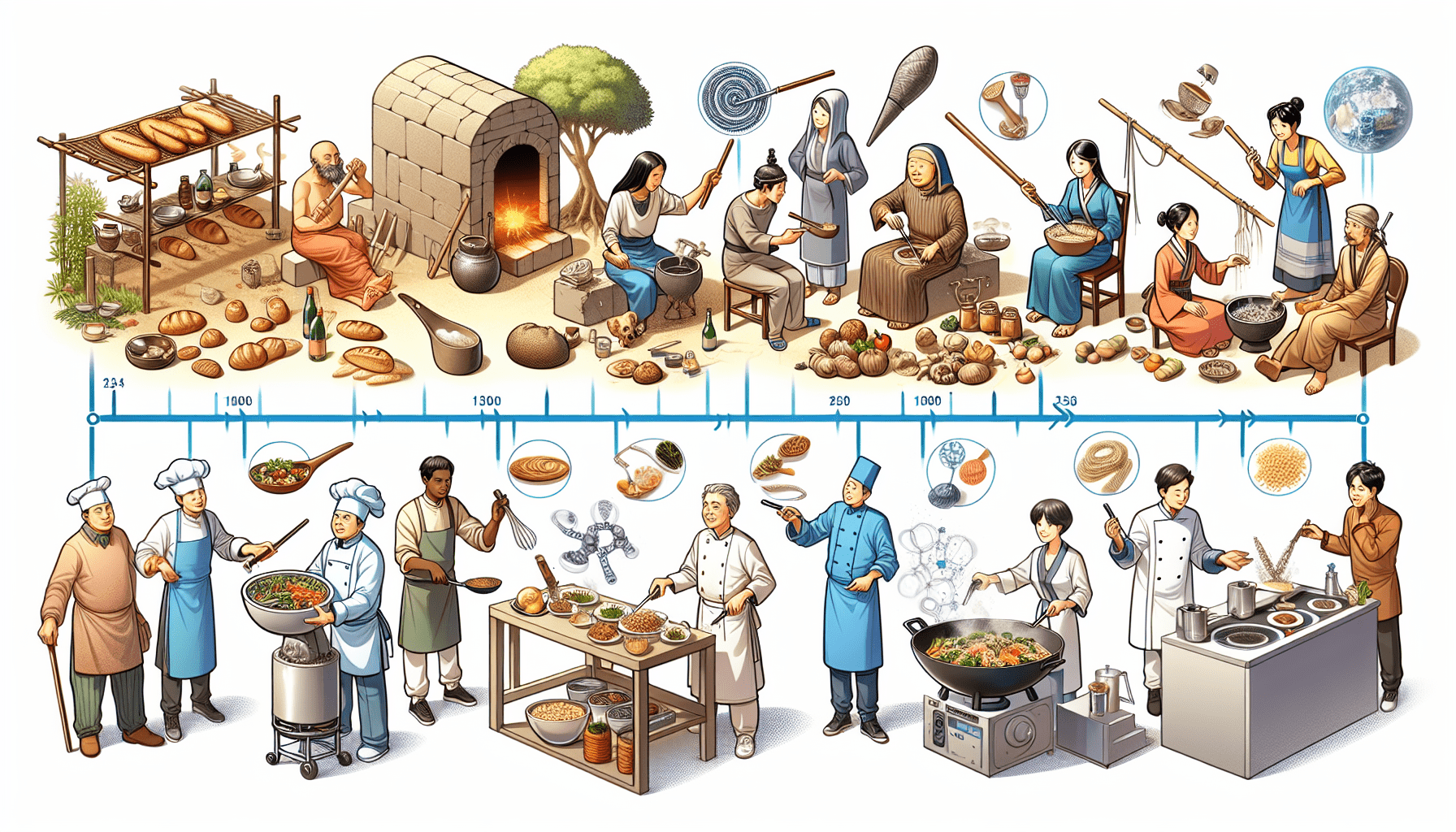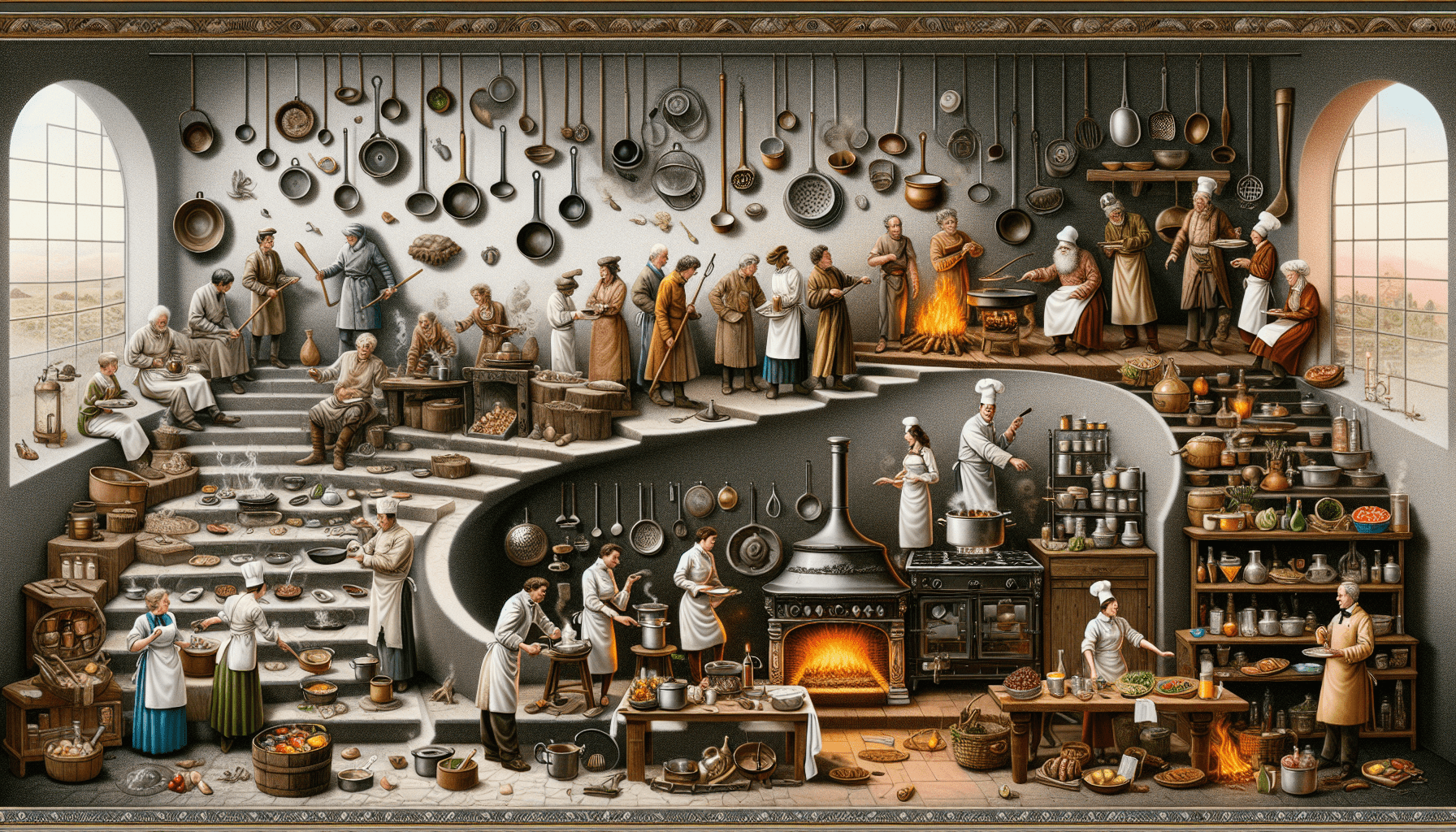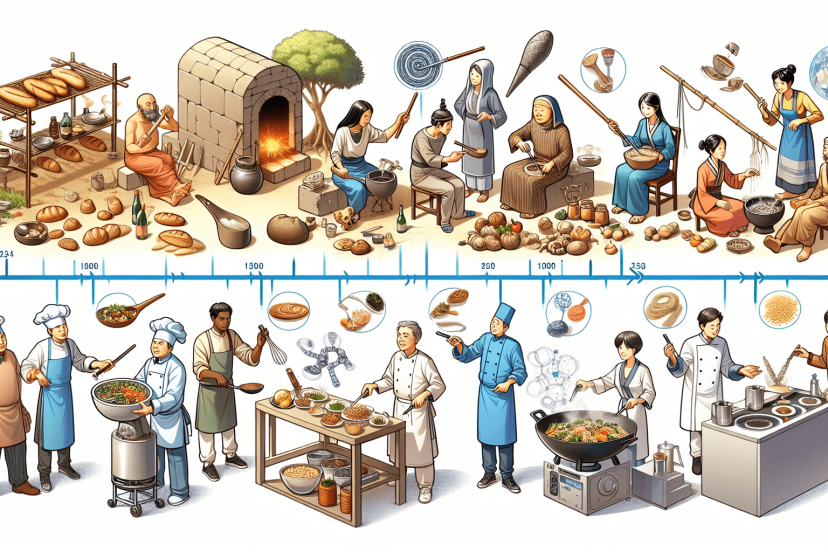How Has Cooking Evolved From Past To Present?
Imagine traveling back in time to ancient civilizations where cooking was a primal necessity for survival. As you watch it unfold before your eyes, you see how cooking techniques, ingredients, and even the role of food in society have drastically transformed over the centuries. Fast forward to the present day and you’ll find a culinary world that is vibrant, diverse, and constantly evolving. In this article, we will explore the fascinating journey of how cooking has evolved from the past to the present, uncovering the remarkable changes that have shaped the way we cook and enjoy food today.

Introduction
Cooking is a fundamental aspect of human life that has evolved significantly over time. From the discovery of fire to the emergence of molecular gastronomy, cooking has transformed from a basic survival skill to an art form. Through the ages, various factors such as the invention of cooking tools, the development of culinary techniques, advancements in technology, and the influence of different cultures have shaped the way we prepare food. This article explores the rich history of cooking, highlighting the major milestones and their impact on our culinary traditions.
Discovery of Fire
The discovery of fire was a turning point in the evolution of cooking. It is believed that early humans discovered fire accidentally, either through volcanic activity or by harnessing the power of natural wildfires. The ability to control fire revolutionized cooking, providing warmth, protection, and a means to prepare food. Fire allowed for the transformation of raw ingredients into edible and delicious meals, marking the beginning of culinary exploration.
Impact of fire on cooking
The use of fire for cooking had numerous impacts on early human societies. Firstly, fire made food safer to consume, as it helped eliminate harmful microorganisms and parasites that could cause illness. Secondly, cooking with fire improved the digestibility of food, as heat breaks down complex molecules, making nutrients more accessible to the human body. Lastly, fire brought people together, promoting communal eating and social bonding, which played a crucial role in the development of human culture.
Advantages of using fire for cooking
The advantages of using fire for cooking were significant. Fire provided heat, allowing humans to cook food, facilitating the extraction of flavors, and softening the texture of tough ingredients. It also made it possible to customize the taste of food by adding aromatic herbs, spices, and seasonings. Moreover, cooking with fire helped preserve food for longer periods, ensuring a more reliable food supply. Overall, fire allowed early humans to enhance their eating experiences, leading to better nutrition and a greater variety of flavors.
Invention of Cooking Tools
As human civilizations began to develop, the need for more efficient cooking methods and tools became apparent. The invention of cooking tools marked another milestone in the evolution of cooking, enabling the exploration of new culinary techniques and the creation of more elaborate dishes.
Primitive cooking tools
Early cooking tools were simple and made from natural materials such as wood, stone, and animal bones. These tools included hand-held knives for cutting and peeling, wooden spoons for stirring, and pointed sticks for skewering and roasting food over an open flame. The invention of pottery allowed for the creation of ceramic vessels that could withstand high heat, enabling boiling and stewing of ingredients.
Importance of cooking tools in food preparation
Cooking tools played a vital role in food preparation by making it easier and more efficient. Cutting tools allowed for precise slicing, chopping, and mincing of ingredients, enhancing the visual appeal and texture of cooked dishes. Utensils like spoons and spatulas facilitated stirring, mixing, and flipping of food, ensuring even cooking. The introduction of more specialized tools such as grinders, mortars, and pestles enabled the grinding of spices and the creation of pastes, enhancing the depth of flavors. Overall, cooking tools were essential in transforming basic ingredients into delicious meals and expanding the possibilities of culinary creativity.

Development of Culinary Techniques
As cooking tools advanced, so did the culinary techniques used in food preparation. Various methods emerged, each with its unique characteristics and advantages. The development of culinary techniques contributed to the diversity and complexity of dishes, paving the way for new cooking styles and flavors.
Roasting and grilling
Roasting and grilling were among the earliest cooking techniques. Roasting involved cooking food over an open flame or hot coals, while grilling referred to cooking food on a grate or grill. These techniques imparted a smoky flavor and created a delicious charred crust on the outside of the food, enhancing its taste and texture. Roasting and grilling allowed for the preparation of various types of meat, fish, and vegetables, adding depth and richness to the flavors.
Boiling and stewing
Boiling and stewing involved cooking food in a liquid, usually water or broth. Boiling was used for quick cooking, while stewing involved longer cooking times at lower temperatures. These techniques allowed for the extraction of flavors from ingredients, resulting in rich and savory broths or sauces. Boiling and stewing were particularly useful for tenderizing tougher cuts of meat, making them more palatable and easier to digest.
Frying and sautéing
Frying and sautéing involved cooking food in hot fat or oil. Frying was typically done in deep oil, while sautéing used a smaller amount of oil and involved stirring or tossing the ingredients in a pan. These techniques created crispy exteriors and imparted a delicious caramelized flavor to the food. Frying and sautéing allowed for the preparation of a wide range of dishes, including crispy fried chicken, golden French fries, and stir-fried vegetables.
Baking and broiling
Baking and broiling were techniques commonly used for cooking in an enclosed space with dry heat. Baking involved cooking food in an oven, while broiling referred to cooking food under direct heat. These techniques led to the development of various baked goods, such as bread, cakes, and pastries. Baking and broiling allowed for the creation of tender and moist textures, while also providing a golden crust on the outside.
Steaming and pressure cooking
Steaming and pressure cooking utilized steam to cook food. Steaming involved placing food on a rack above simmering water, allowing the steam to envelop and cook the ingredients. Pressure cooking, on the other hand, used a sealed container to trap steam under high pressure, resulting in faster cooking times. These techniques preserved the natural flavors and nutrients of the ingredients, enabling healthy and flavorful dishes. Steaming and pressure cooking were particularly useful for delicately cooked vegetables, perfectly steamed rice, and tender meats.
Agricultural Revolution and Domestication of Food
The Agricultural Revolution, which took place around 10,000 years ago, was a significant turning point in human history. During this period, humans transitioned from a hunter-gatherer lifestyle to settled agricultural communities. The cultivation of crops and domestication of animals had a profound impact on food availability, dietary diversity, and the overall development of human civilization.
Cultivation of crops and domestication of animals
The Agricultural Revolution introduced a systematic approach to food production. Humans began cultivating crops like grains, fruits, and vegetables, allowing for a more predictable and abundant food supply. With the domestication of animals, humans acquired a continuous source of meat, dairy, and other animal products. The ability to grow crops and raise animals in a controlled environment led to the development of permanent settlements, the establishment of complex societies, and the rise of civilization.
Impact on food availability and variety
The cultivation of crops and domestication of animals significantly increased food availability and dietary variety. Instead of relying solely on naturally occurring fruits, roots, and game, humans could now produce a wide range of crops and rear livestock for their sustenance. This led to the introduction of staple crops like rice, wheat, and corn, which formed the basis of many ancient civilizations’ diets. The domestication of animals also provided an additional source of protein, dairy, and other essential nutrients. The Agricultural Revolution laid the foundation for the emergence of diverse cuisines, as different regions began cultivating and utilizing unique crops and raising specific animals.
Influence of Migration and Trade
Throughout history, human migration and trade have played a crucial role in the exchange of culinary practices, ingredients, and cooking techniques. As civilizations expanded and connected through trade routes, culinary traditions blended and adapted, resulting in the introduction of new flavors and cooking techniques.
Exchange of culinary practices and ingredients
Migration and trade facilitated the exchange of culinary practices and ingredients across different regions. As people traveled and settled in new areas, they brought with them their cooking techniques, recipes, and food preferences. This led to the fusion of different culinary traditions, resulting in the creation of unique dishes and flavors. Additionally, trade routes allowed for the transportation of spices, herbs, and other exotic ingredients, enriching the culinary repertoire of different cultures.
Introduction of new flavors and cooking techniques
The exchange of culinary practices and ingredients brought about the introduction of new flavors and cooking techniques. For example, the Silk Road, a network of trade routes connecting Asia, Europe, and Africa, played a vital role in the spread of spices and aromatic ingredients. The introduction of spices like cinnamon, pepper, and cardamom revolutionized the flavor profiles of dishes, creating a demand for new and exciting tastes. Similarly, cooking techniques such as stir-frying, steaming, and pickling were exchanged and adopted, adding diversity to cooking methods and expanding culinary horizons.
Industrial Revolution and Mass Production
The Industrial Revolution, which began in the 18th century, transformed all aspects of human society, including cooking. With the invention of new technologies and the rise of mass production, the way people prepared and consumed food changed drastically.
Invention of kitchen appliances and utensils
The Industrial Revolution introduced various kitchen appliances and utensils that revolutionized cooking. Inventions such as the stove, oven, refrigerator, and electric mixer made cooking more practical and efficient. These appliances provided better temperature control, enabled simultaneous cooking of multiple dishes, and facilitated food storage. Utensils like metal pots, pans, and spatulas replaced traditional cooking tools, offering superior heat distribution and durability.
Standardization of food production
The Industrial Revolution also brought about the standardization of food production. With the advent of large-scale food processing, the consistency and quality of ingredients improved significantly. The rise of industrialized farming led to the mass production of crops and livestock, resulting in a more reliable and affordable food supply. Standardization also extended to processed foods, with the development of canned goods, preserved sauces, and packaged meals. These changes allowed for the widespread availability of once-seasonal ingredients and convenience foods.
Impact on cooking methods and time
The introduction of kitchen appliances and the standardization of food production had a profound impact on cooking methods and time. Cooking became more accessible to a broader range of people, as the new technologies simplified complex processes and reduced manual labor. The availability of pre-packaged ingredients and ready-to-cook meals further expedited meal preparation. Consequently, the time spent in the kitchen decreased significantly, giving individuals more time for other pursuits. However, this convenience came with trade-offs, as the industrialization of food production often sacrificed the authenticity and nutritional value of traditional cooking methods.
Influence of Science and Technology
Advancements in science and technology have continued to shape the way we cook and eat. From the introduction of new cooking techniques to innovations in food preservation and packaging, science and technology have opened up new possibilities in the culinary world.
Introduction of new cooking techniques
Science and technology have brought about new cooking techniques that were once unimaginable. For example, the invention of sous vide cooking involves vacuum-sealing food and immersing it in a precisely controlled water bath. This technique allows for precise temperature control, resulting in tender and evenly cooked dishes. Similarly, the advent of molecular gastronomy explores the physical and chemical transformations of ingredients, leading to the creation of unique textures, flavors, and presentations.
Innovation in food preservation and packaging
Science and technology have also revolutionized food preservation and packaging methods. Refrigeration and freezing technologies have extended the shelf life of perishable ingredients, allowing for year-round availability. The introduction of canning, bottling, and vacuum-sealing techniques has further increased the longevity of food, reducing waste and ensuring food safety. Moreover, advancements in packaging materials have improved food preservation, while also considering environmental sustainability.
Emergence of Molecular Gastronomy
Molecular gastronomy represents the fusion of culinary arts and scientific principles. It explores the physical and chemical properties of ingredients and applies them to create unique flavors, textures, and presentations.
Application of scientific principles in cooking
Molecular gastronomy involves the application of scientific principles, such as chemistry and physics, in the culinary field. Chefs and scientists collaborate to understand the interactions between ingredients, temperatures, and cooking techniques, leading to innovative culinary creations. Techniques like spherification, foams, and gels allow for the transformation of familiar ingredients into surprising and delightful culinary experiences.
Creation of unique flavors and textures
Molecular gastronomy has expanded the boundaries of flavor and texture combinations. By manipulating the structure and composition of ingredients, chefs can create foods with unexpected textures, such as airy foams, crunchy gels, and creamy spheres. The combination of flavors from diverse ingredients, coupled with innovative techniques, results in multi-sensory dining experiences that challenge traditional notions of taste and texture.
Conclusion
The evolution of cooking has been a remarkable journey, demonstrating the ingenuity and creativity of humankind. From the discovery of fire to the emergence of molecular gastronomy, our culinary practices have transformed from basic survival skills to sophisticated art forms. Each milestone, whether it be the invention of cooking tools, the development of culinary techniques, or advancements in science and technology, has contributed to the rich history and diversity of cuisines worldwide. As we continue to explore new flavors, techniques, and traditions, cooking will remain a dynamic and ever-evolving aspect of human culture.




